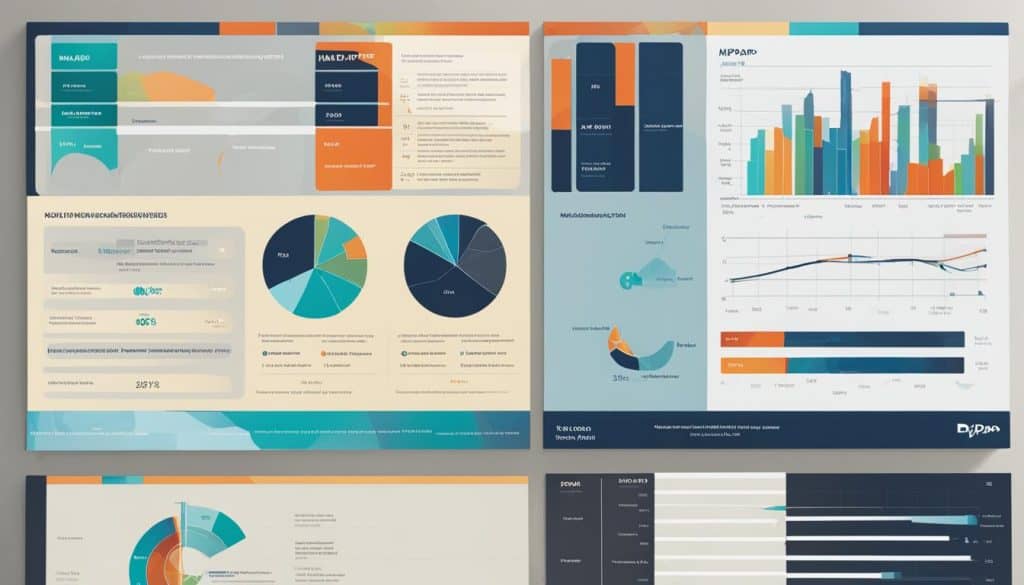If you are nearing or have reached the age of 65, you may be wondering which Medicare healthcare option is best for you. With so many options available, it can be a daunting task to determine which type of plan will provide you with the coverage you need at a price you can afford. This is where understanding the key differences between MAPD and PDP plans comes into play.
MAPD (Medicare Advantage with Prescription Drug) plans and PDP (Prescription Drug) plans are two types of healthcare options that provide prescription drug coverage. While they may seem similar, they have some distinct differences that can greatly impact your healthcare and out-of-pocket expenses. In this comprehensive guide, we will compare and contrast these healthcare options, equipping you with the knowledge necessary to make an informed decision.
Key Takeaways:
- Understanding the differences between MAPD and PDP plans is essential to choose the right healthcare option for you.
- MAPD plans combine medical and prescription drug coverage, while PDP plans only cover prescription drugs.
- MAPD plans often have lower out-of-pocket expenses but also have a restricted provider network.
- PDP plans allow you to choose from a wide selection of providers but can have higher out-of-pocket expenses.
- Factors such as costs, coverage, enrollment processes, and your individual medical needs should be carefully considered before making a decision.
Medicare Advantage Plans vs Prescription Drug Plans
If you are eligible for Medicare, there are various healthcare options available to you, including Medicare Advantage plans and Prescription Drug plans. While these two types of plans may seem similar at first glance, there are some key differences to consider before making a decision.
Comparing MAPD and PDP Plans
One of the biggest differences between Medicare Advantage plans and Prescription Drug plans is that MAPD plans provide both medical and prescription drug coverage, while PDP plans only cover prescription drugs. With a MAPD plan, you get all of the benefits of Medicare Parts A and B, as well as prescription drug coverage.
On the other hand, with a PDP plan, you would need to pair it with Original Medicare or a Medicare Supplement plan to get full medical coverage. This means you would have two separate plans instead of one. However, a PDP plan may be a good option if you already have medical coverage through another source, such as an employer or union.
Another difference to consider is that MAPD plans are offered by private insurance companies approved by Medicare, while PDP plans are standalone plans also offered by private insurance companies. This means that you may have more options to choose from with a MAPD plan, as different insurance companies may offer different benefits and costs.
Benefits and Coverage
Both MAPD and PDP plans offer coverage for a range of prescription drugs, but the specific medications covered may differ between plans. With a MAPD plan, you may also have access to additional benefits such as dental, vision, and hearing coverage, which may not be included in a PDP plan.
When it comes to medical coverage, a MAPD plan may offer more comprehensive coverage than a PDP plan. However, this can depend on the specific plan you choose, so it’s important to carefully review the details of each plan before making a decision.
Advantages and Disadvantages
| Advantages of MAPD Plans | Advantages of PDP Plans |
|---|---|
|
|
Disadvantages:
|
Disadvantages:
|
Choosing the Right Plan for You
When deciding between a MAPD plan and a PDP plan, it’s important to consider your individual healthcare needs and budget. A MAPD plan may be a good choice if you want comprehensive coverage in one plan, while a PDP plan may be a better fit if you already have medical coverage through another source.
Factors to consider when comparing costs include premiums, deductibles, copays, and out-of-pocket maximums. You can also compare the specific benefits and coverage offered by different plans to see which one aligns best with your needs and preferences.
It’s also important to note that enrollment periods for these plans may differ, so it’s important to check the enrollment deadlines for each plan to ensure you don’t miss any important deadlines.

In summary, while MAPD plans offer a more comprehensive and affordable healthcare option, PDP plans are often a suitable choice for seniors who have extensive prescription drug needs.
Choosing Between MAPD and PDP Plans: Costs and Enrollment
Before choosing between MAPD and PDP plans, it’s vital to consider the costs associated with each option. This includes premiums, deductibles, copayments, and other out-of-pocket expenses.
MAPD plans typically have higher monthly premiums, but they offer comprehensive coverage for both medical services and prescription drugs. On the other hand, PDP plans have lower monthly premiums, but they only cover prescription drugs.
If you have a chronic condition or require regular medical care, a MAPD plan may better suit your needs. If you only need prescription drug coverage and do not require medical services, a PDP plan may be a more cost-effective option.
When enrolling in a MAPD or PDP plan, it’s important to understand the enrollment processes and deadlines. You can enroll in Medicare Advantage plans during the Annual Enrollment Period (AEP), which is from October 15 to December 7 each year, or during the Initial Enrollment Period (IEP) when you first become eligible for Medicare.
Enrollment in PDP plans follows the same schedule as MAPD plans during the AEP and IEP. However, if you miss these deadlines, you can enroll in a PDP plan during the Open Enrollment Period (OEP), which runs from January 1 to March 31 every year.
Comparing MAPD and PDP Plan Costs
| Cost Category | MAPD Plan | PDP Plan |
|---|---|---|
| Monthly Premium | Higher | Lower |
| Deductible | Varies by plan | Varies by plan |
| Copayment for Medical Services | Varies by plan | Not Covered |
| Copayment for Prescription Drugs | Varies by plan | Varies by plan |
| Total Out-of-Pocket Maximum | Varies by plan | $6,550 (in 2021) |
Note: These cost categories are generalizations and can vary depending on the specific plan you choose. Always review the plan documents and speak to a licensed insurance agent to fully understand the costs of each option.
Choosing between MAPD and PDP plans can be overwhelming, but understanding the costs and enrollment processes can make the decision easier. Consider your individual healthcare needs and budget before making a final decision.

Differences and Comparisons
Overall, the biggest difference between MAPD and PDP plans is the medical benefits they offer. While both plans include prescription drug coverage, MAPD plans also provide additional medical benefits such as dental, vision, and hearing. PDP plans, on the other hand, only cover prescription drugs. Additionally, MAPD plans may have different costs and enrollment processes than PDP plans, so it’s important to carefully review and compare each option to determine which plan is the best fit for your healthcare needs and budget.
Conclusion
After exploring the key differences between MAPD and PDP plans, it’s important to make a decision based on your unique healthcare needs. Remember to consider factors such as the type of coverage and benefits you require, associated costs, and the enrollment process.
One important consideration is consulting with a professional, like Integrity Now Insurance Brokers, an independent Medicare agency. They can offer expert guidance and support in selecting the most suitable plan for your individual circumstances.
Take Action Today
Don’t wait until it’s too late to secure the right healthcare coverage for your needs. Take the necessary steps today to enroll in an appropriate MAPD or PDP plan, and enjoy peace of mind knowing that you are protected.
FAQ
What is the difference between MAPD and PDP plans?
MAPD (Medicare Advantage with Prescription Drug) plans provide comprehensive coverage that includes medical services and prescription drugs. PDP (Prescription Drug) plans, on the other hand, only cover prescription drugs and do not include medical services.
How do Medicare Advantage plans and Prescription Drug plans compare?
Medicare Advantage plans offer a broader range of coverage, including medical services, hospital stays, and prescription drugs. Prescription Drug plans solely focus on providing coverage for prescription medications.
What benefits and coverage do MAPD plans provide?
MAPD plans typically cover a wide range of medical services, including doctor visits, hospital stays, preventive care, and prescription drugs. These plans often include additional benefits such as dental, vision, and hearing coverage.
What is the coverage provided by PDP plans?
PDP plans specifically focus on providing coverage for prescription drugs. They usually include a list of covered medications, known as a formulary, and may have different tiers that determine the cost of each drug.
How do I choose between MAPD and PDP plans based on costs and enrollment?
When considering costs, it’s important to compare premiums, deductibles, copayments, and out-of-pocket expenses for both MAPD and PDP plans. Additionally, understanding the enrollment process for each type of plan is crucial in making an informed decision.
What are the key differences and comparisons between MAPD and PDP plans?
The main difference lies in the coverage provided, with MAPD plans offering comprehensive medical and prescription drug coverage, while PDP plans solely cover prescription drugs. Comparing the features, benefits, and limitations of both types of plans can help you determine which one aligns better with your healthcare needs.










